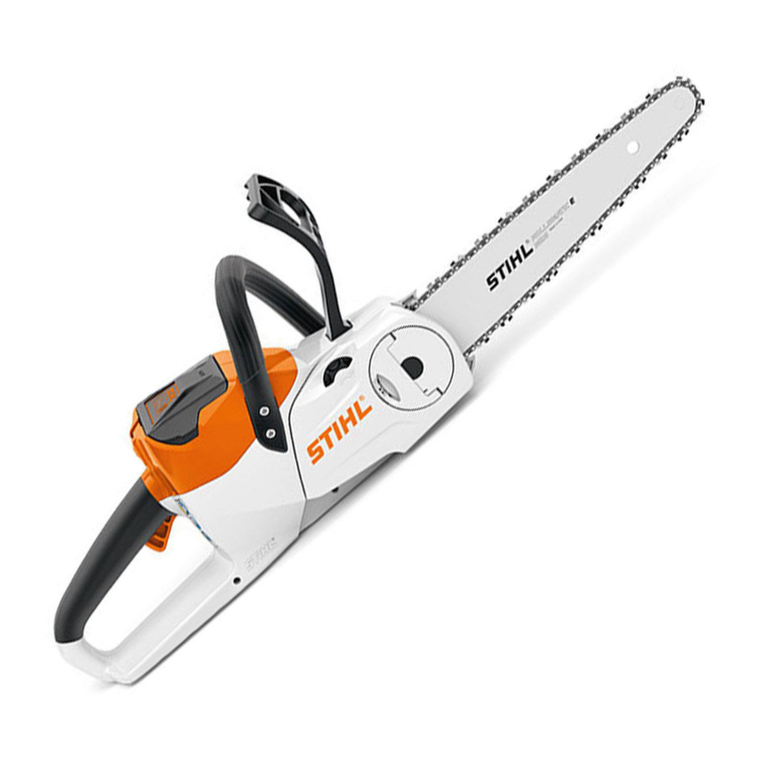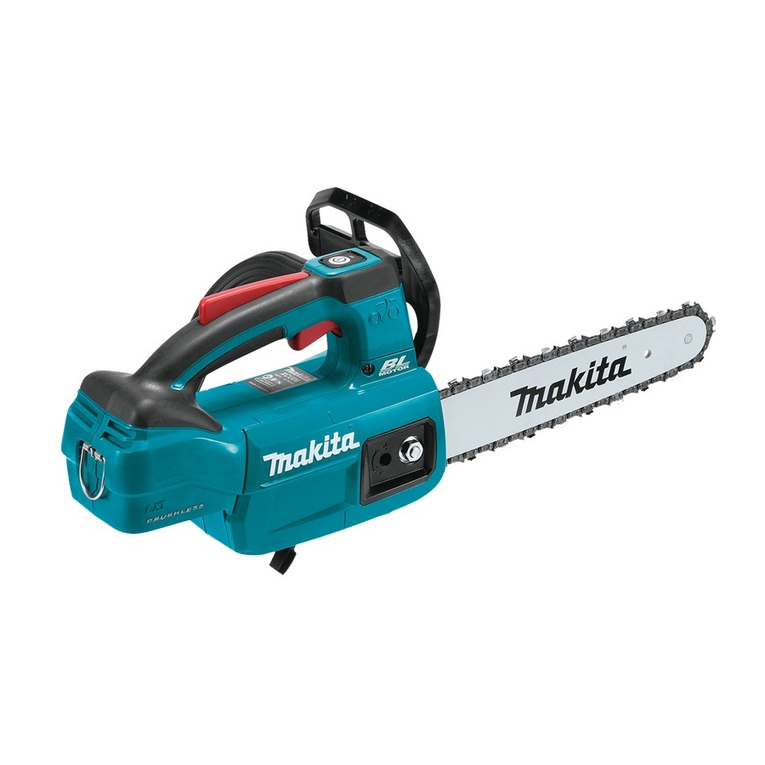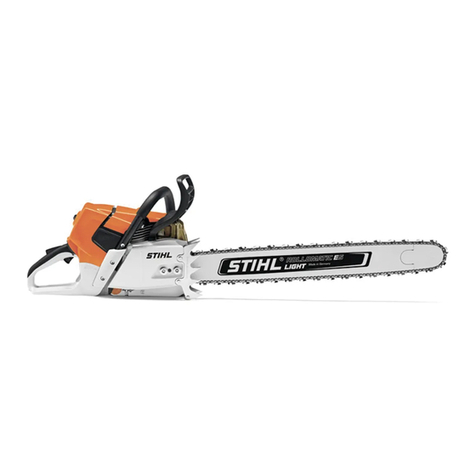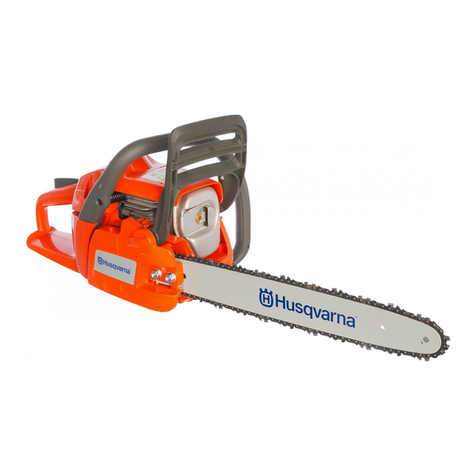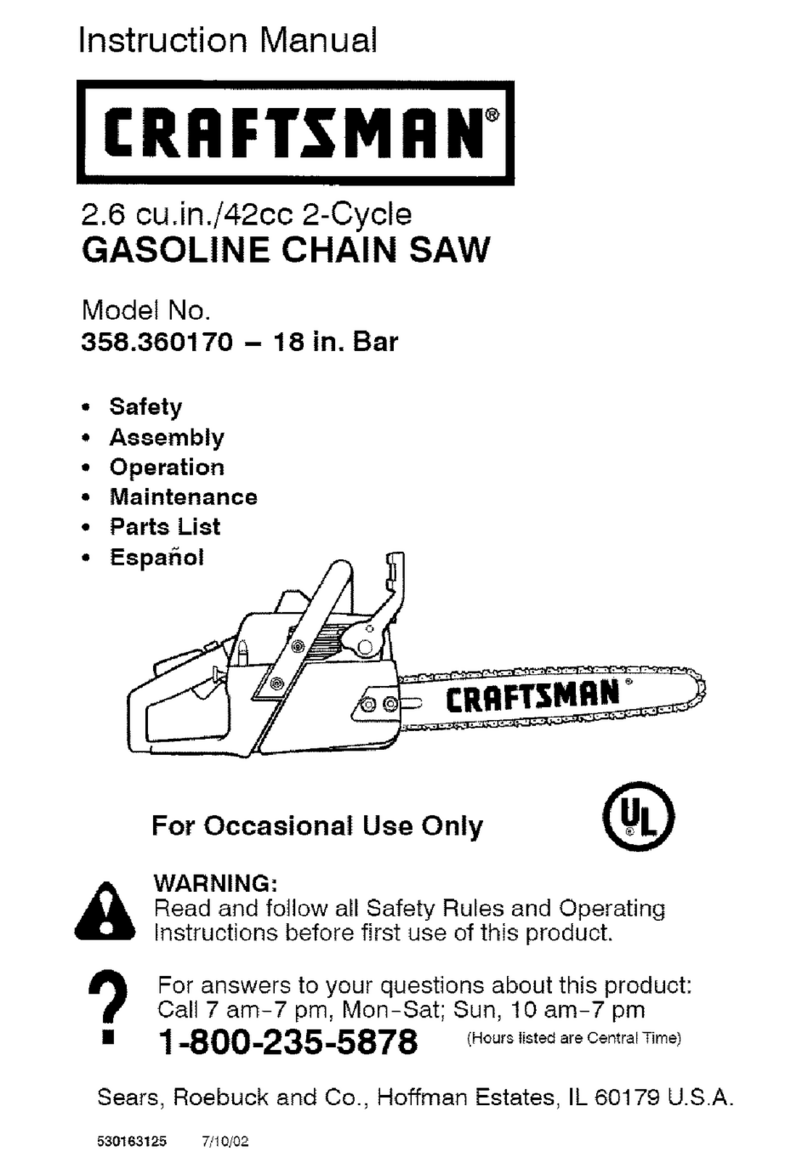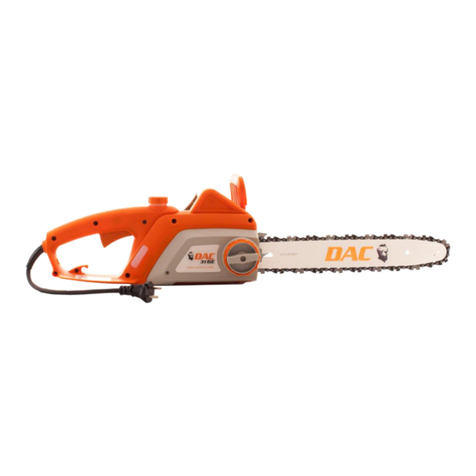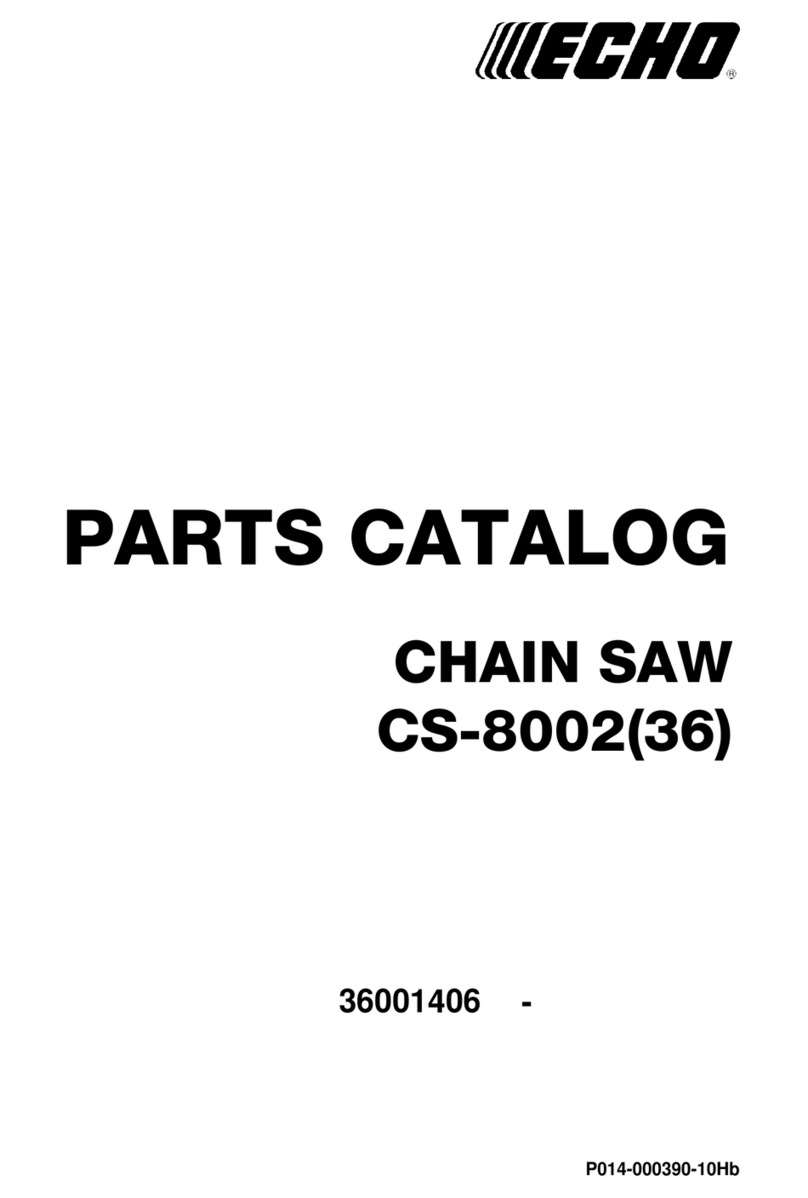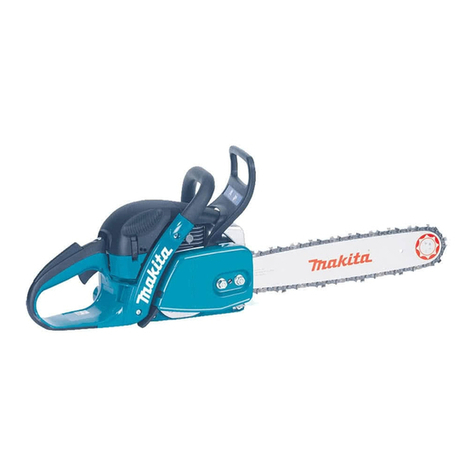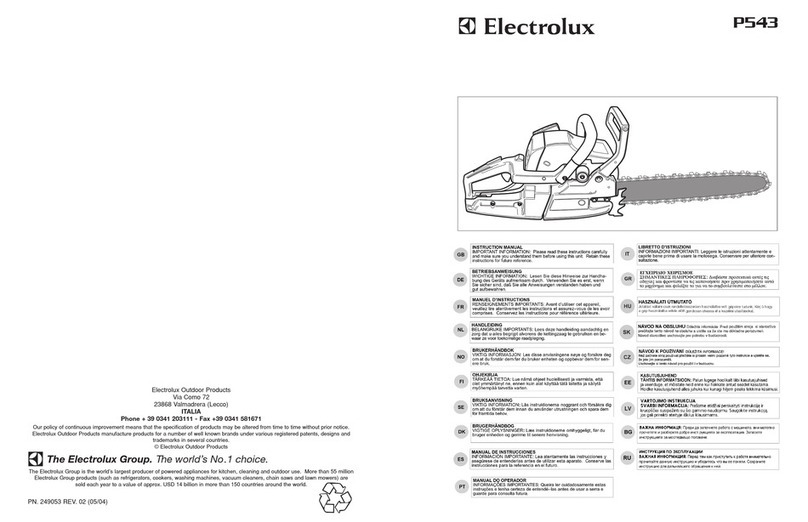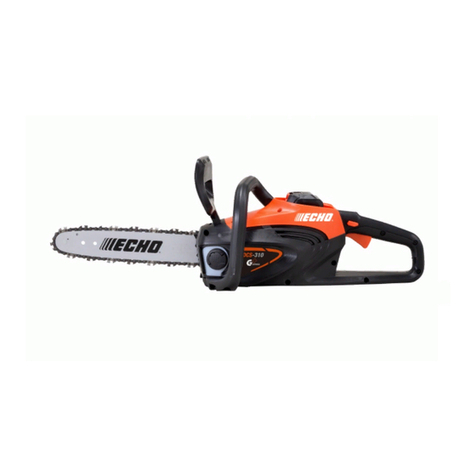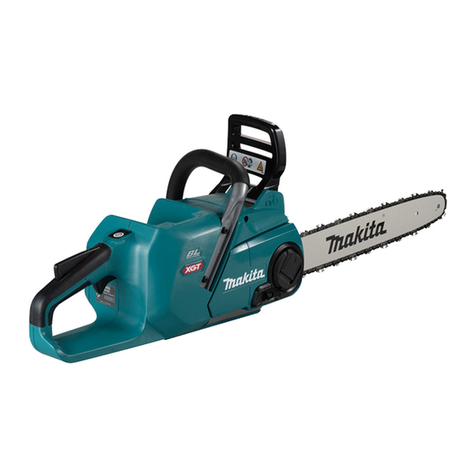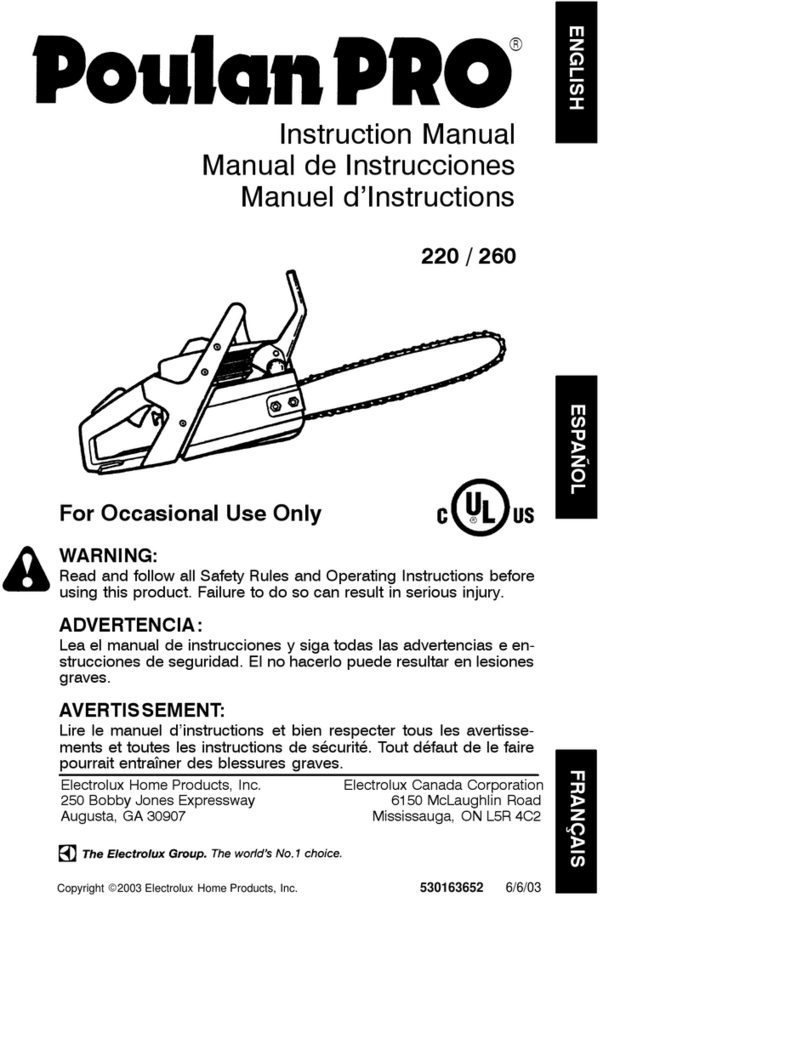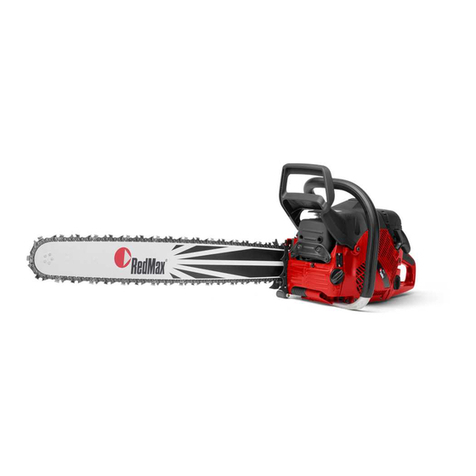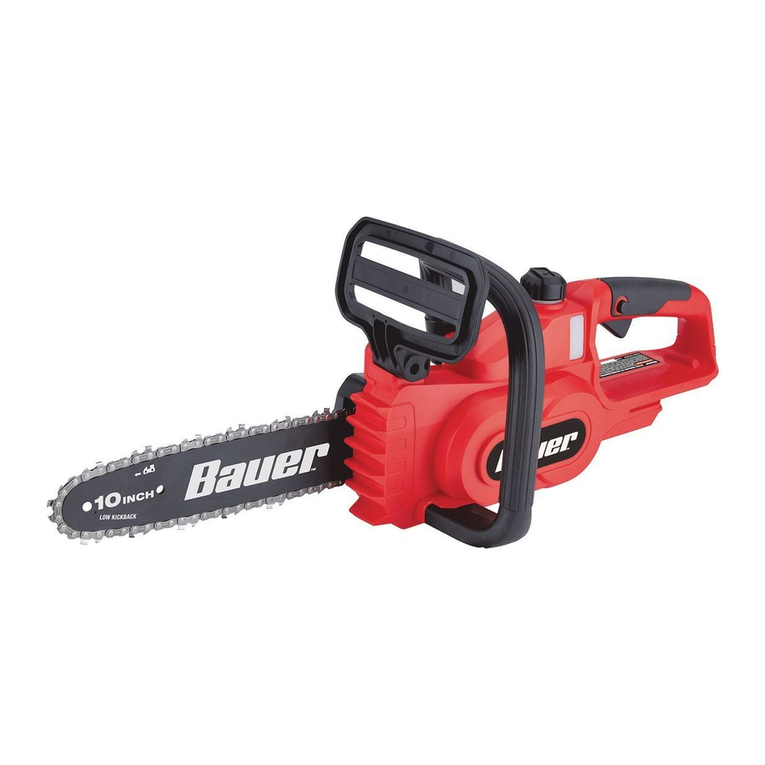BBT BT-CS-40 User manual

OWNER’S MANUAL
Assembly & Operating Instructions
MODEL NO. BT-CS-40
BBT 40cc Chainsaw

2
WWW.BBTA.COM.AU
To The Owner
Thank You!
Thank you for purchasing our Chainsaw. It was carefully engineered to provide excellent performance when
properly operated and maintained.
Please read this entire manual prior to operating the chainsaw. It instructs you how to safely and easily set
up, operate and maintain your chainsaw. Please be sure that you, and any other persons who will operate the
chainsaw, carefully follow the recommended safety practices at all times. Failure to do so could result in personal
injury or property damage.
All information in this manual is relative to the most recent product information available at the time of printing.
Review this manual frequently to familiarize yourself with the machine, its features and operation. Please be
aware that this Owner’s Manual may cover a range of product specifications for various models. Characteristics
and features discussed and/or illustrated in this manual may not be applicable to all models. We reserve the right
to change product specifications, designs and equipment without notice and without incurring obligation.
All the power testing information used to establish the power rating of the engine equipped on these chainsaws
can be found at the engine manufacturer’s manual or website. If you have any problems or questions concerning
the machine, contact our Customer Support Department.
Throughout this manual, all references to right and left side of the chainsaw are observed from the operating
position. The engine manufacturer is responsible for all engine-related issues with regards to performance,
power-rating, specifications, warranty and service. Please refer to the engine manufacturer’s Owner’s Manual
packed separately with your chainsaw for more information.
Customer Support
Please do NOT return the chainsaw without first contacting the Customer Support Department at
bbt@bbta.com.au.
If you have difficulty assembling this product or have any questions regarding the controls, operation, or
maintenance of this chainsaw, please contact our Customer Support Department.
SAVE THESE INSTRUCTIONS
BT-CS-40

3
WWW.BBTA.COM.AU
TABLE OF CONTENTS
Page(s) Page(s)
To The Owner......................................................................2
Customer Support...............................................................2
TABLE OF CONTENTS ..........................................3
IMPORTANT SAFETY INFORMATION .............. 4-5
Key to symbols ....................................................................5
WHAT IS WHAT?..................................................6
GENERAL SAFETY PRECAUTIONS................. 7-14
Before using a new chainsaw.............................................7
Always use common sense .................................................7
Personal protective equipment..........................................8
Chainsaw’s safety equipment.............................................8
Chain brake and front hand guard....................................8
Throttle lock........................................................................9
Chain catcher ....................................................................10
Right hand guard..............................................................10
Vibration damping system ...............................................10
Stop switch ........................................................................10
Muffler ..............................................................................10
Cutting equipment ...........................................................10
General rules .....................................................................10
Cutting equipment designed to reduce kickback...........11
Sharpening your chain and
adjusting depth gauge setting.........................................12
Lubricating cutting equipment........................................13
Chain oil ............................................................................13
Filling with chain oil .........................................................13
Checking chain lubrication...............................................13
Chain drive sprocket .........................................................14
Needle bearing lubrication ..............................................14
Checking wear on cutting equipment.............................14
ASSEMBLY..........................................................15
Fitting the bar and chain..................................................15
FUEL HANDLING.......................................... 16-17
Fuel ....................................................................................16
Two-stroke oil....................................................................16
Mixing................................................................................16
Chain oil ............................................................................16
Fuelling..............................................................................17
Fuel safety .........................................................................17
Transport and storage ......................................................17
Long-term storage ............................................................17
STARTING AND STOPPING .......................... 18-19
Starting engine .................................................................18
Stopping ............................................................................19
Carburettor anti-freeze mechanism ................................19
How to switch between operating modes......................19
WORKING TECHNIQUES.............................. 20-26
Before use .........................................................................20
General working instructions...........................................20
Basic safety rules ...............................................................20
General rules .....................................................................21
Basic cutting techniques...................................................22
Limbing..............................................................................22
Cutting...............................................................................22
Tree felling technique.......................................................23
Felling ................................................................................24
Freeing a tree that has fallen badly ................................25
Cutting trees and branches that are in tension ..............25
How to avoid kickback .....................................................26
Limbing..............................................................................26
Cutting the trunk into logs ..............................................26
MAINTENANCE............................................ 27-32
General ..............................................................................27
Function.............................................................................27
Basic settings and running in ...........................................27
Fine adjustment ................................................................27
Conditions .........................................................................27
Low speed jet L .................................................................27
Fine adjustment of the idling speed T.............................27
High speed jet H ...............................................................27
Correctly adjusted carburettor.........................................28
Checking, maintaining and
servicing chainsaw safety equipment..............................28
Chain brake and front hand guard..................................28
Checking the inertia brake release..................................28
Checking the brake trigger ..............................................28
Throttle lock......................................................................28
Chain catcher ....................................................................29
Right hand guard..............................................................29
Vibration damping system ...............................................29
Stop switch ........................................................................29
Muffler ..............................................................................29
Starter................................................................................29
Changing a broken or worn starter cord ........................29
Tensioning the recoil spring .............................................30
Changing a broken recoil spring......................................30
Fitting the starter..............................................................30
Air filter .............................................................................30
Spark plug .........................................................................30
Lubricating the bar tip sprocket ......................................31
Needle bearing lubrication ..............................................31
Adjustment of the oil pump.............................................31
Cooling system ..................................................................31
“Air Injection” centrifugal cleaning ................................31
Maintenance schedule......................................................32
TROUBLESHOOTING..........................................34
SPECIFICATIONS.................................................35
WARRANTY & SERVICE .....................................36
Warranties.........................................................................36
Spare Parts.........................................................................36
EXPLODED DIAGRAM & PARTS LIST........... 37-39
BT-CS-40

4
WWW.BBTA.COM.AU
IMPORTANT SAFETY INFORMATION
WARNING: Read and thoroughly understand all instructions in this manual and on the safety decals
before assembling or operating this chainsaw. Failure to do so may cause serious injury or death.
Do not allow anyone to operate this chainsaw who has not read this manual. As with all power
equipment, a chainsaw can be dangerous if assembled or used improperly. Do not operate this
chainsaw if you have any questions concerning its safe operation. To get answers to any questions,
call our Customer Support Department.
This SAFETY ALERT SYMBOL identifies important safety messages in this manual. Failure to follow
this important safety information may result in serious injury or death.
DANGER! This chainsaw was built to be operated according to the safe operation practices in this
manual. As with any type of power equipment, carelessness or error on the part of the operator can
result in serious injury. This chainsaw is capable of amputating hands and feet and throwing debris.
Failure to observe the following safety instructions could result in serious injury or death.
The following signals words and meanings are intended to explain the levels of risk associated with this product.
DANGER indicates a hazardous situation which, if not followed, will result in serious injury
or death.
WARNING indicates a hazardous situation which, if not avoided, could result in serious injury
or death.
CAUTION indicates a hazardous situation which, if not avoided, could result in minor or
moderate injury.
NOTICE is important information about the proper use of your chainsaw. Failure to follow
this instruction could result in damage to your chainsaw or property.
BT-CS-40

5
WWW.BBTA.COM.AU
IMPORTANT SAFETY INFORMATION
Key to symbols
Symbol Description
READ THE OWNER’S MANUAL(S)
Read, understand and follow all instructions in the manual(s) before attempting to assemble
and operate.
FACE PROTECTION
Always wear safety goggles or safety glasses with side shields, or a face shield when operating
this product as well as ear protection.
WEAR GLOVES
Always wear nonslip, heavy-duty protective gloves when operating this product.
WEAR SAFETY FOOTWEAR
Always wear nonslip steel-toed safety footwear when operating this product.
TWO HANDS OPERATION
Both of the operator’s hands must be used to operate the chainsaw. Never operate a chainsaw
holding it with one hand only.
WARNING—KICKBACK
Tip contact may cause the guide bar to move suddenly upward and backward (kickback), which
may cause serious injury.
STOP—SWITCH OFF BEFORE CARRYING
Switch off the engine by moving the stop switch to the STOP position before carrying out any
checks or maintenance.
CHAIN BRAKE
The chain brake must be engaged when the chainsaw is started.
REFILL THE 2 STROKE MIXTURE
Petrol and oil mixture.
REFILL THE CHAIN OIL
CHOKE
Pulling out the choke knob, the choke closes.
Pushing in the choke knob, the choke opens.
CHAIN OILER ADJUSTMENT
“
-
” direction the oil flow decreases
“+’’ direction the oil flow increases
CARBURETTOR ADJUSTMENT
H: High speed mixture
L: Low speed mixture
T: Idle speed
CHAIN OIL
MAX
+MIN
-
BT-CS-40

6
WWW.BBTA.COM.AU
WHAT IS WHAT?
1. Owner’s manual
2. Starter handle
3. Adjuster screws, carburettor
4. Stop switch (Ignition on/off switch.)
5. Rear handle
6. Choke control/Start throttle lock
7. Fuel tank
8. Starter
9. Throttle lock
10. Cylinder cover
11. Front handle
12. Front hand guard
13. Muffler
14. Chain
15. Bar
16. Bumper spike
17. Chain catcher
18. Chain tensioning screw
19. Oil pump adjustment screw
20. Clutch cover
21. Throttle control
22. Combination spanner
23. Bar guard
24. Primer bulb (if applicable)
24
BT-CS-40

7
WWW.BBTA.COM.AU
Before using a new chainsaw
• Please read this manual carefully.
• Check that the cutting equipment is correctly fitted and
adjusted. See instructions under Assembly.
• Refuel and start the chainsaw. See instructions under
Fuel Handling and Starting and Stopping.
• Do not use the chainsaw until sufficient chain oil has
reached the chain. See instructions under Lubricating
cutting equipment.
• Long-term exposure to noise can result in permanent
hearing impairment. So always use approved hearing
protection.
WARNING! Under no circumstances may
the design of the chainsaw be modified
without the express permission of the
manufacturer. Always use genuine
accessories. Non-authorised modifications
and/or accessories can result in serious personal injury
or the death of the operator or others. Your warranty
may not cover damage or liability caused by the use of
non-authorised accessories or replacement parts.
IMPORTANT!
The chainsaw is only designed for cutting wood.
You should only use the chainsaw with the bar and chain
combinations we recommend in the Specifications.
Never use the chainsaw if you are fatigued, while
under the influence of alcohol or drugs, medication
or anything that could affect your vision, alertness,
coordination or judgement.
Wear personal protective equipment. See instructions
under Personal protective equipment.
Do not modify this product or use it if it appears to
have been modified by others.
Never use a chainsaw that is faulty. Carry out all checks,
maintenance and service instructions described in this
manual. Some maintenance and service measures must
be carried out by trained and qualified specialists. See
instructions under Maintenance.
Never use any accessories other than those
recommended in this manual. See instructions under
Cutting equipment and Specifications.
CAUTION! Always wear protective glasses or a face
visor to reduce the risk of injury from thrown objects.
A chainsaw is capable of throwing objects, such as
wood chips, small pieces of wood, etc., at great force.
This can result in serious injury, especially to the eyes.
GENERAL SAFETY PRECAUTIONS
WARNING! A chainsaw is a dangerous tool
if used carelessly or incorrectly and can
cause serious, even fatal injuries. It is very
important that you read and understand
the contents of this owner’s manual.
WARNING! The inside of the muffler
contains chemicals thatmaybe carcinogenic.
Avoid contact with these elements in the
event of a damaged muffler.
WARNING! Running an engine in a
confined or badly ventilated area can result
in death due to asphyxiation or carbon
monoxide poisoning.
WARNING! Long-term inhalation of the
engine’s exhaust fumes, chain oil mist and
dust from sawdust can represent a health
risk.
WARNING! Faulty cutting equipment or
the wrong combination of bar and saw
chain increases the risk of kickback! Only
use the bar/saw chain combinations we
recommend, and follow the filing instructions. See
instructions under Specifications
Always use common sense
It is not possible to cover every conceivable situation you can face when using a chainsaw.
Always exercise care and use your common sense. Avoid all situations which you consider
to be beyond your capability. If you still feel uncertain about operating procedures after
reading these instructions, you should consult an expert before continuing. Do not hesitate
to contact us if you have any questions about the use of the chainsaw. We will willingly
be of service and provide you with advice as well as help you to use your chainsaw both
efficiently and safely.
BT-CS-40

8
WWW.BBTA.COM.AU
Personal protective equipment
• Approved protective helmet
• Hearing protection
• Protective goggles or a visor
• Gloves with chainsaw protection
• Trousers with chainsaw protection
• Boots with chainsaw protection, steel toe-cap and non-slip sole
• Always have a first aid kit nearby
• Fire extinguisher and shovel
• Clothes should be close-fitting without restricting your freedom of movement.
GENERAL SAFETY PRECAUTIONS
WARNING! Most chainsaw accidents happen when the chain touches the operator. You must use approved
personal protective equipment whenever you use the chainsaw. Personal protective equipment cannot
eliminate the risk of injury but it will reduce the degree of injury if an accident does happen.
IMPORTANT! Sparks can come from the muffler, the bar and chain or other sources. Always have fire extinguishing
tools available if you should need them. Help prevent forest fires.
Chainsaw’s safety equipment
In this section, the chainsaw’s safety features and their
function are explained. For inspection and maintenance
see instructions under Checking, maintaining and servicing
chainsaw safety equipment. See instructions under What
is what?, to find where these parts are located on your
chainsaw.
The life span of the chainsaw can be reduced, and the risk of
accidents can increase if chainsaw maintenance is not carried
out correctly and if service and/or repairs are not carried
out professionally. If you need further information, please
contact our Customer Support Department.
Chain brake and front hand guard
Your chainsaw is equipped with a chain brake that is
designed to stop the chain if you get a kickback. The chain
brake reduces the risk of accidents, but only you can prevent
them.
Take care when using your chainsaw and make sure the
kickback zone of the bar never touches any object.
• The chain brake (A) can either be activated manually (by
your left hand) or automatically by the inertia release
mechanism.
• The brake is applied when the front hand guard (B) is
pushed forwards.
• This movement activates a spring-loaded mechanism
that tightens the brake band (C) around the engine
drive system (D) (clutch drum).
• The front hand guard is not designed solely to activate
the chain brake. Another important feature is that it
reduces the risk of the chain hitting your left hand if
you lose grip of the front handle.
• The chain brake must be engaged when the chainsaw is
started to prevent the saw chain from rotating.
WARNING! Never use a chainsaw with
defective safety components. Safety
equipment must be inspected and
maintained. See instructions under
Checking, maintaining and servicing chainsaw
safety equipment. If your chainsaw does not pass
all the checks, please contact our Customer Support
Department.
BT-CS-40

9
WWW.BBTA.COM.AU
• Use the chain brake as a “parking brake” when starting
and when moving over short distances, to reduce the
risk of the moving chain accidentally hitting your leg, or
anyone or anything close by.
• To release the chain brake pull the front hand guard
backwards, towards the front handle.
• Kickback can be very sudden and violent. Most kickbacks
are minor and do not always activate the chain brake. If
this happens you should hold the chainsaw firmly and
not let go.
• The way the chain brake is activated, either manually
or automatically by the inertia release mechanism,
depends on the force of the kickback and the position of
the chainsaw in relation to the object that the kickback
zone of the bar strikes.
• If you get a violent kickback while the kickback zone
of the bar is farthest away from you, the chain brake is
designed to be activated by the inertia in the kickback
direction.
• If the kickback is less violent, or the kickback zone of the
bar is closer to you, the chain brake is designed to be
activated manually by the movement of your left hand.
• In the felling position, the left hand is in a position that
makes manual activation of the chain brake impossible.
With this type of grip, that is when the left hand is
placed so that it cannot affect the movement of the
front hand guard, the chain brake can only be activated
by the inertia action.
Will my hand always activate the chain brake
during a kickback?
No. It takes a certain force to move the hand guard forward.
If your hand only lightly touches the front guard or slips over
it, the force may not be enough to trigger the chain brake.
You should also maintain a firm grip on the chainsaw handles
while working. If you do and experience a kickback, your
hand may never leave the front handle and will not activate
the chain brake, or the chain brake will only activate after
the chainsaw has swung around a considerable distance. In
such instances, the chain brake might not have enough time
to stop the saw chain before it touches you.
There are also certain positions in which your hand cannot
reach the front hand guard to activate the chain brake; for
example, when the saw chain is held in the felling position.
Will my inertia activated chain brake always
activate during kickback in the event of a kickback?
No. First, your brake must be in working order. Testing the
brake is simple. We recommend you do before you begin
each work session. Second, the kickback must be strong
enough to activate the chain brake. If the chain brake is too
sensitive it would activate all the time which would be a
nuisance.
Will my chain brake always protect me from injury
in the event of a kickback?
No. First, the chain brake must be in working order to provide
the intended protection. Second, it must be activated during
the kickback as described above to stop the saw chain. Third,
the chain brake may be activated, but if the bar is too close
to you, the brake might not have enough time to slow down
and stop the chain before the chainsaw hits you.
Only you and proper working technique can eliminate
kickback and its danger.
Throttle lock
The throttle lock is designed to prevent accidental operation
of the throttle control. When you press the lock (A) (i.e. when
you grasp the handle) it releases the throttle control (B).
When you release the handle, the throttle control and the
throttle lock both move back to their original positions. This
arrangement means that the throttle control is automatically
locked at the idle setting.
GENERAL SAFETY PRECAUTIONS
BT-CS-40

10
WWW.BBTA.COM.AU
Chain catcher
The chain catcher is designed to catch the chain if it snaps
or jumps off. This should not happen if the chain is properly
tensioned (see instructions under Assembly) and if the
bar and chain are properly serviced and maintained (see
instructions under General working instructions).
Right hand guard
Apart from protecting your hand if the chain jumps or
snaps, the right-hand guard stops branches and twigs from
interfering with your grip on the rear handle.
Vibration damping system
Your chainsaw is equipped with a vibration damping system
that is designed to reduce vibration and make operation
easier.
The chainsaw’s vibration damping system reduces the
transfer of vibration between the engine unit/cutting
equipment and the chainsaw’s handle unit.
The body of the chainsaw, including the cutting equipment,
is insulated from the handles by vibration damping units.
Cutting hardwoods (most broadleaf trees) creates more
vibration than cutting softwoods (most conifers). Cutting
with cutting equipment that is blunt or faulty (wrong type
or badly sharpened) will increase the vibration level.
Stop switch
Use the stop switch to switch off the engine.
Muffler
The muffler is designed to keep noise levels to a minimum
and to direct exhaust fumes away from the user.
In areas with a hot, dry climate there is a high risk of fires.
These areas are sometimes subject to government rules
requiring among other things the muffler must be equipped
with an approved type of spark arrestor mesh.
Cutting equipment
This section describes how to choose and maintain your
cutting equipment in order to:
• Reduce the risk of kickback.
• Reduce the risk of the saw chain breaking or jumping
off the bar.
• Obtain optimal cutting performance.
• Extend the life of cutting equipment.
• Avoid increasing vibration levels.
General rules
• Only use cutting equipment recommended by us! See
instructions under Specifications.
GENERAL SAFETY PRECAUTIONS
WARNING! Overexposure to vibration can
lead to circulatory damage or nerve damage
in people who have impaired circulation.
Contact your doctor if you experience
symptoms of overexposure to vibration. Such
symptoms include numbness, loss of feeling, tingling,
pricking, pain, loss of strength, changes in skin colour
or condition. These symptoms normally appear in
the fingers, hands or wrists. These symptoms may be
increased in cold temperatures.
WARNING! The exhaust fumes from the
engine are hot and may contain sparks,
which can start a fire. Never start the
chainsaw indoors or near combustible
material!
WARNING! Never use a chainsaw without
a muffler, or with a damaged muffler.
A damaged muffler may substantially
increase the noise level and the fire hazard.
Keep fire fighting equipment handy.
CAUTION! The muffler gets very hot during and after
use. This also applies during idling. Be aware of the
fire hazard, especially when working near flammable
substances and/ or vapours.
BT-CS-40

11
WWW.BBTA.COM.AU
• Keep the chain’s cutting teeth properly sharpened!
Follow our instructions and use the recommended file
gauge. A damaged or badly sharpened chain increases
the risk of accidents.
• Maintain the correct depth gauge setting! Follow our
instructions and use the recommended depth gauge
clearance. Too large a clearance increases the risk of
kickback.
• Keep the chain properly tensioned! If the chain is slack
it is more likely to jump off and lead to increased wear
on the bar, chain and drive sprocket.
• Keep cutting equipment well lubricated and properly
maintained! A poorly lubricated chain is more likely to
break and lead to increased wear on the bar, chain and
drive sprocket.
Cutting equipment designed to reduce kickback
The only way to avoid kickback is to make sure that the
kickback zone of the bar never touches anything.
By using cutting equipment with “built-in” kickback
reduction and keeping the chain sharp and well-maintained
you can reduce the effects of kickback.
Bar
The smaller the tip radius the lower the chance of kickback.
Chain
A chain is made up of a number of links, which are available
in standard and low-kickback versions
Some terms that describe the bar and chain
To maintain the safety features of the cutting equipment,
you should replace a worn or damaged bar or chain with a
bar and chain combinations recommended by us.
See instructions under Specifications for a list of replacement
bar and chain combinations we recommend.
Bar
• Length (inches/cm)
• Number of teeth on bar tip sprocket (T).
• Chain pitch (inches). The spacing between the drive
links of the chain must match the spacing of the teeth
on the bar tip sprocket and drive sprocket.
• Number of drive links. The number of drive links is
determined by the length of the bar, the chain pitch and
the number of teeth on the bar tip sprocket.
• Bar groove width (inches/mm). The groove in the bar
must match the width of the chain drive links.
• Chain oil hole and hole for chain tensioner. The bar must
be matched to the chainsaw design.
Chain
• Chain pitch (inches)
• Drive link width (mm/inches)
• Number of drive links.
GENERAL SAFETY PRECAUTIONS
WARNING! Faulty cutting equipment or
the wrong combination of bar and saw
chain increases the risk of kickback! Only
use the bar/saw chain combinations we
recommend, and follow the filing instructions. See
instructions under Specifications.
IMPORTANT! No saw chain design eliminates the
danger of kickback
BT-CS-40

12
WWW.BBTA.COM.AU
Sharpening your chain and adjusting depth gauge
setting
General information on sharpening cutting teeth
• Never use a blunt chain. When the chain is blunt you
have to exert more pressure to force the bar through
the wood and the chips will be very small. If the chain
is very blunt it will produce wood powder and no chips
or shavings.
• A sharp chain eats its way through the wood and
produces long, thick chips or shavings.
• The cutting part of the chain is called the cutter and
consists of a cutting tooth (A) and the depth gauge
(B). The cutters cutting depth is determined by the
difference in height between the two (depth gauge
setting).
When you sharpen a cutting tooth there are four important
factors to remember.
1. Filing angle
2. Cutting angle
3. File position
4. Round file diameter
It is very difficult to sharpen a chain correctly without the
right equipment. We recommend that you use our file
gauge. This will help you obtain the maximum kickback
reduction and cutting performance from your chain.
See instructions under Specifications for information about
sharpening your chain.
Sharpening cutting teeth
To sharpen cutting teeth, you will need a round file and a file
gauge. See instructions under Specifications for information
on the size of the file and gauge that are recommended for
the chain fitted to your chainsaw.
• Check that the chain is correctly tensioned. A slack chain
will move sideways, making it more difficult to sharpen
correctly.
• Always file cutting teeth from the inside face. Reduce
the pressure on the return stroke. File all the teeth on
one side first, then turn the chainsaw and file the teeth
on the other side.
• File all the teeth to the same length. When the length of
the cutting teeth is reduced to 4 mm (0.16”) the chain is
worn out and should be replaced.
General advice on adjusting depth gauge setting
• When you sharpen the cutting tooth (A), the depth
gauge setting (C) will decrease. To maintain optimal
cutting performance the depth gauge (B) has to be
filed down to achieve the recommended depth gauge
setting.
See instructions under Specifications to find the correct
depth gauge setting for your particular chain.
Adjustment of depth gauge setting
• The cutting teeth should be newly sharpened before
adjusting the depth gauge setting. We recommend that
you adjust the depth gauge setting every third time you
sharpen the cutting teeth.
• You will need a flat file and a depth gauge tool. We
recommend that you use our depth gauge tool to
GENERAL SAFETY PRECAUTIONS
WARNING! Departure from the sharpening
instructions considerably increases the risk
of kickback.
WARNING! The risk of kickback is increased
if the depth gauge setting is too large!
NOTE: This recommendation assumes that the length
of the cutting teeth is not reduced excessively.
BT-CS-40

13
WWW.BBTA.COM.AU
achieve the correct depth gauge setting and bevel for
the depth gauge.
• Place the depth gauge tool over the chain. Detailed
information regarding the use of the depth gauge tool
will be found on the package for the depth gauge tool.
Use the flat file to file off the tip of the depth gauge
that protrudes through the depth gauge tool. The
depth gauge setting is correct when you no longer feel
resistance as you draw the file along the depth gauge
tool.
Tensioning the chain
The more you use a chain the longer it becomes. It is
therefore important to adjust the chain regularly to take up
the slack.
Check the chain tension every time you refuel.
• Loosen the bar nuts that hold the clutch cover/chain
brake. Use the combination spanner. Then tighten the
bar nuts by hand as tight as you can.
• Raise the tip of the bar and stretch the chain by tightening
the chain tensioning screw using the combination
spanner. Tighten the chain until it does not sag from the
underside of the bar.
• Use the combination spanner to tighten the bar nuts
while lifting the tip of the bar at the same time. Check
that you can pull the chain round freely by hand and
that it does not sag from the underside of the bar.
The position of the chain tensioning screw on our chainsaws
varies from model to model. See instructions under What is
what? to find out where it is on your model.
Lubricating cutting equipment
Chain oil
Chain oil must demonstrate good adhesion to the chain and
maintain its flow characteristics regardless of whether it is
warm summer or cold winter weather.
As a chainsaw manufacturer, we have developed an optimal
chain oil that has a vegetable oil base.
Never use waste oil! Using waste oil can be dangerous to
you and can damage your chainsaw and the environment.
Filling with chain oil
• All our chainsaws have an automatic chain lubrication
system. On some models the oil flow is also adjustable.
• The saw chain oil tank and the fuel tank are designed so
that the fuel runs out before the saw chain oil.
However, this safety feature requires that you:
a. Use the right sort of chain oil (if the oil is too thin it
will run out before the fuel);
b. Adjust the carburettor as recommended (a lean
mixture may mean that the fuel lasts longer than
the oil); and
c. Use the recommended cutting equipment (a bar
that is too long will use more chain oil).
Checking chain lubrication
• Check the chain lubrication each time you refuel.
Aim the tip of the bar at a light coloured surface about
20cm (8 inches) away. After 1 minute running at 3/4
throttle you should see a distinct line of oil on the light
surface.
GENERAL SAFETY PRECAUTIONS
WARNING! A slack chain may jump off the
bar and cause serious or even fatal injury.
NOTE: A new chain has a running-in period during
which you should check the tension more frequently.
WARNING! Poor lubrication of cutting
equipment may cause the chain to snap,
which could lead to serious, even fatal
injuries.
BT-CS-40

14
WWW.BBTA.COM.AU
If the chain lubrication is not working:
• Check that the oil channel in the bar is not obstructed.
Clean if necessary.
• Check that the groove in the edge of the bar is clean.
Clean if necessary.
• Check that the bar tip sprocket turns freely and that the
lubricating hole in the tip sprocket is not blocked. Clean
and lubricate if necessary.
If the chain lubrication system is still not working after
carrying out the above checks and associated measures you
should contact our Customer Support Department.
Chain drive sprocket
The clutch drum is fitted with the following drive sprocket:
Spur sprocket (the chain sprocket is welded on the drum)
Regularly check the degree of wear on the drive sprocket.
Replace if wear is excessive. Replace the drive sprocket
whenever you replace the chain.
Needle bearing lubrication
Both versions of sprockets have a needle bearing on the
drive shaft, which has to be greased regularly (once a week).
Checking wear on cutting equipment
Check the chain daily for:
• Visible cracks in rivets and links.
• Whether the chain is stiff.
• Whether rivets and links are badly worn.
Replace the saw chain if it exhibits any of the points above.
We recommend you compare the existing chain with a new
chain to decide how badly the existing chain is worn.
When the length of the cutting teeth has worn down to only
4mm (0.16 inchs) the chain must be replaced.
Bar
Check regularly:
• Whether there are burrs on the edges of the bar. Remove
these with a file if necessary.
• Whether the groove in the bar has become badly worn.
Replace the bar if necessary.
• Whether the tip of the bar is uneven or badly worn. If a
hollow forms on the underside of the bar tip this is due
to running with a slack chain.
• To prolong the life of the bar, you should turn it over
daily.
GENERAL SAFETY PRECAUTIONS
WARNING! Most chainsaw accidents
happen when the chain touches the
operator.
Wear personal protective equipment. See
instructions under Personal protective equipment.
Do not tackle any job that you feel you are not
adequately trained for. See instructions under Personal
protective equipment.
Avoid situations where there Is a risk of kickback. See
instructions under Chainsaw’s safety equipment.
Use the recommended protective equipment and
check its condition. See instructions under General
working instructions.
Check that all the chainsaw safety features are working.
See Instructions under General working instructions
and General safety precautions.
BT-CS-40

15
WWW.BBTA.COM.AU
ASSEMBLY
Fitting the bar and chain
Check that the chain brake is in the disengaged position by
moving the front hand guard towards the front handle.
Remove the bar nuts and remove the clutch cover (chain
brake). Take off the transportation ring (A).
Fit the bar over the bar bolts. Place the bar in its rearmost
position. Place the chain over the drive sprocket and locate it
in the groove on the bar. Begin on the top edge of the bar.
Make sure that the edges of the cutting links are facing
forward on the top edge of the bar.
Fit the clutch cover and locate the chain adjuster pin in
the hole in the bar. Check that the drive links of the chain
fit correctly over the drive sprocket and that the chain is
correctly located in the groove in the bar. Tighten the bar
nuts finger tight.
Tension the chain by turning the chain tensioning screw
clockwise using the combination spanner.
The chain is correctly tensioned when it does not sag from
the underside of the bar, but can still be turned easily by
hand. Hold up the bar tip and tighten the bar nuts with the
combination spanner.
When fitting a new chain, the chain tension has to be
checked frequently until the chain is run-in. Check the chain
tension regularly. A correctly tensioned chain ensures good
cutting performance and longer chain life.
WARNING! Always wear gloves, when
working with the chain, in order to protect
your hands from injury.
NOTE: If the clutch cover is difficult to remove, replace
bar nuts, engage brake and rerelease (an audible click
will be heard if released properly).
BT-CS-40

16
WWW.BBTA.COM.AU
FUEL HANDLING
Fuel
• This engine is certified to operate on unleaded fuel 95+
RON (research octane number) avoid ethanol.
• Use good quality unleaded gasoline. Engines equipped
with catalytic converters must be run on unleaded fuel
mixtures.
• The lowest recommended octane grade is RON 95. If you
run the engine on a lower octane grade than RON 95
so called knocking can occur. This gives rise to a high
engine temperature and increased bearing load, which
can result in serious engine damage.
• When working with continuous high revs (FB grade) a
higher octane is recommended.
Environment fuel
We recommends the use of alkylate fuel or environment
fuel for four-stroke engines blended with two- stroke oil
as set out below. Note that carburettor adjustment may be
necessary when changing the type of fuel (see instructions
under Carburettor).
Running-in
Avoid running at a too high speed for extended periods
during the first 10 hours of operation.
Two-stroke oil
• For best results and performance use two- stroke oil,
which is specially formulated for our two-stroke engines.
• Never use two-stroke oil intended for water-cooled
outboard engines, sometimes referred to as outboard
oil.
• Never use oil intended for four-stroke engines.
Mixing ratio
For all engines: 1:25 (4%)
Petrol (litre) Two-stroke oil (litre)
4% (1:25)
5 L 0.20 L
10 L 0.40 L
15 L 0.60 L
20 L 0.80 L
Mixing
• Always mix the fuel and oil in a clean container intended
for fuel.
• Always start by filling half the amount of the fuel to be
used. Then add the entire amount of oil. Mix (shake) the
fuel mixture. Add the remaining amount of gasoline.
• Mix (shake) the fuel mixture thoroughly before filling
the chainsaw’s fuel tank.
• Do not mix more than one month’s supply of fuel at a
time.
• If the chainsaw will not be used for an extended period
of time, the fuel tank should be emptied and cleaned.
Chain oil
• We recommend the use of special oil (chain oil) with
good adhesion characteristics.
• Never use waste oil. This results in damage to the oil
pump, the bar and the chain.
• It is important to use oil of the right grade (suitable
viscosity range) to suit the air temperature.
• In temperatures below 0°C, some oils become too
viscous. This can overload the oil pump and result in
damage to the oil pump components.
• Contact your service agent when choosing chain oil.
WARNING! Always ensure there is adequate
ventilation when handling fuel.
NOTE: The chainsaw is equipped with a two-stroke
engine and must always be run using a mixture of
fuel and two-stroke oil. It is important to accurately
measure the amount of oil to be mixed to ensure that
the correct mixture is obtained. When mixing small
amounts of fuel, even small inaccuracies can drastically
affect the ratio of the mixture.
BT-CS-40

17
WWW.BBTA.COM.AU
Fuelling
Clean the area around the fuel cap. Clean the fuel and chain
oil tanks regularly. The fuel filter must be replaced at least
once a year. Contamination in the tanks causes malfunction.
Make sure the fuel is well mixed by shaking the container
before refuelling. The capacities of the chain oil tank and
fuel tank are carefully matched. You should therefore always
fill the chain oil tank and fuel tank at the same time.
Fuel safety
• Never refuel the chainsaw while the engine is running.
• Move the chainsaw at least 3m from the refuelling point
before starting it.
• Make sure there is plenty of ventilation when refuelling
or mixing fuel (fuel and 2-stroke oil).
• Never start the chainsaw:
1. If you have spilt fuel or chain oil on the chainsaw. Wipe
off the spillage and allow remaining fuel to evaporate.
2. If you have spilt fuel on yourself or your clothes. Change
your clothes and wash any part of your body that has
come in contact with fuel. Use soap and water.
3. If the chainsaw is leaking fuel. Check regularly for leaks
from the fuel cap and fuel lines
Transport and storage
• Always store the chainsaw and fuel so that there is
no risk of leakages or fumes coming into contact with
sparks or naked flames from electrical equipment,
electric motors, relays/switches, boilers and the like.
• Always store fuel in an approved container designed for
that purpose.
• For longer periods of storage or for transport of the
chainsaw, the fuel and chain oil tanks should be emptied.
Ask where you can dispose of waste fuel and chain oil at
your local gas station.
• Ensure the chainsaw is cleaned and that a complete
service is carried out before long-term storage.
• The bar guard must always be fitted to the cutting
attachment when the chainsaw is being transported or
in storage, in order to prevent accidental contact with
the sharp chain. Even a non-moving chain can cause
serious cuts to yourself or persons you bump into with
an exposed chain.
Long-term storage
Empty the fuel/oil tanks in a well-ventilated area. Store the
fuel in approved containers in a safe place. Fit the bar guard.
Clean the chainsaw. See instructions under Maintenance
schedule.
FUEL HANDLING
WARNING! Taking the following
precautions will lessen the risk of fire:
Do not smoke and do not place any hot
objects in the vicinity of fuel.
Always stop the engine and let it cool for a few minutes
before refuelling.
When refuelling, open the fuel cap slowly so that any
excess pressure is released gently.
Tighten the fuel cap carefully after refuelling.
Always move the chainsaw away from the refuelling
area before starting.
WARNING! Fuel and fuel vapour are highly
flammable. Take care when handling fuel
and chain oil. Be aware of the risks of
fire, explosion and those associated with
inhalation.
WARNING! Never use a chainsaw with
visible damage to the spark plug guard
and ignition cable. A risk of sparking arises,
which can cause a fire.
BT-CS-40

18
WWW.BBTA.COM.AU
Starting engine
1. Push the hand guard forward to engage the chain brake.
2. Pull the choke knob out. Move the ignition, switch to
start position.
3. If the chainsaw is fitted with a decompression valve(A),
please press the valve to reduce the pressure in the
cylinder and make starting easier.
4. Pull the starter handle several times until first firing
sound is heard. Push the choke knob all the way in to
open the choke, then pull the starter handle again.
5. Immediately press and release the throttle when the
engine starts. This will disengage the throttle latch. As
the chain brake is still activated, the engine must return
to latch in order to avoid unnecessary wear on the clutch
assembly.
• Never start a chainsaw unless the bar, chain and all covers
are fitted correctly. See instructions under Assembly.
Without a bar and chain attached to the chainsaw, the
clutch can come loose and cause serious injury.
• Never start the chainsaw indoors. Exhaust fumes can be
dangerous if inhaled.
• The chain brake should be activated when starting. See
instructions under Start and Stop. Do not drop start the
chainsaw. This method is very dangerous as you may
lose control of the chainsaw.
STARTING AND STOPPING
WARNING! Note the following before
starting:
The chain brake must be engaged when the
chainsaw is started to reduce the chance of
contact with the moving chain.
Never start a chainsaw unless the bar, chain and all
covers are fitted correctly. Otherwise, the clutch can
come loose and cause personal injuries.
Place the chainsaw on firm ground. Make sure you
have a secure footing and that the chain cannot touch
anything.
Keep people and animals well away from working
areas.
WARNING! Do not start the engine while
holding the chainsaw with one hand. The
saw chain may touch your body and cause
serious injury.
Do not pull the starter cord all the way out and do
not let go of the starter handle when the cord is fully
extended. This can damage the chainsaw.
WARNING! Long term inhalation of the
engine’s exhaust fumes, chain oil mist and
dust from sawdust can represent a health
risk.
NOTE! Pull the front hand guard towards the front
handle. The chain brake is now disengaged. Your
chainsaw is ready for use.
CAUTION! Once the chainsaw has started the valve
will automatically return to its closed position.
CAUTION! If the starter handle is pulled after the first
firing sound is heard and the choke knob is in the start
position, excess fuel will enter the engine causing the
engine to fail to start.
BT-CS-40

19
WWW.BBTA.COM.AU
• Observe your surroundings and make sure that there is
no risk of people or animals coming into contact with
the cutting equipment.
• Always hold the chainsaw with both hands. The right
hand should be on the rear handle, and the left hand
on the front handle. All people, whether right or left
handed, should use this grip. Use a firm grip with thumbs
and fingers encircling the chainsaw handles.
Stopping
The engine is stopped by pushing the stop switch to the stop
position.
Carburettor anti-freeze mechanism
Operating the chainsaw in temperatures of 0-5°C at times
of high humidity may result in ice forming within the
carburettor. This may cause the output power of the engine
to be reduced or for the engine to fail to operate smoothly.
This product has accordingly been designed with a ventilation
hatch at the back of the air cleaner cover to allow warm air
to be supplied to the engine and to thereby prevent icing
from occurring. (For some other models, a hot wind cover
can adjust the hot air intake.)
Under normal circumstances, the product should be used
in normal operating mode, which it is set at the time of
shipment.
However, when the possibility exists that icing may occur,
the unit should be set to operate in anti-freeze mode before
use.
How to switch between operating
modes
A. Switching by air filter cover
1. Flip the engine switch to turn off the engine.
2. Remove the air cleaner cover from the cylinder cover.
3. Re-attach the screen right side left so as to the anti-icing
plate is on the right. Reinstall the cover.
B. Switching by hot wind cover
1. Flip the engine switch to turn off the engine.
2. Remove the air cleaner cover from the cylinder cover.
3. Revolve the hot wind cover to the Anti-freeze mode.
4. Re-install the cover.
STARTING AND STOPPING
WARNING! Continuing to use the chainsaw
in anti-freeze mode once temperatures have
risen and returned to normal may result in
the engine failing to start properly or in
the engine failing to operate at its normal speed. For
this reason you should always ensure the unit is set to
normal operating mode if there is no danger of icing
occurring.
1. Air cleaner cover
2. Hot wind cover
3. Normal operating mode
4. Anti-freeze mode
1. Air cleaner cover
2. Anti-icing plate
3. Screw
4. Normal operating mode
5. Anti-freeze mode
6. Screen
BT-CS-40

20
WWW.BBTA.COM.AU
Before use
1. Check that the chain brake works correctly and is not
damaged.
2. Check that the rear right hand guard is not damaged.
3. Check that the throttle lock works correctly and is not
damaged.
4. Check that the stop switch works correctly and is not
damaged.
5. Check that all handles are free from oil.
6. Check that the anti vibration system works and is not
damaged.
7. Check that the muffler is securely attached and not
damaged.
8. Check that all parts of the chainsaw are tightened
correctly and that they are not damaged or missing.
9. Check that the chain catcher is in place and not damaged.
10. Check the chain tension.
General working instructions
Basic safety rules
1. Look around you:
• To ensure that people, animals or other things cannot
affect your control of the chainsaw.
• To make sure that none of the above might come within
reach of your saw or be injured by falling trees.
2. Do not use the chainsaw in bad weather, such as dense
fog, heavy rain, strong wind, intense cold, etc. Working
in bad weather is tiring and often brings added risks,
such as icy ground, unpredictable felling direction, etc.
3. Take great care when removing small branches and
avoid cutting bushes (i.e. cutting many small branches
at the same time). Small branches can be grabbed by
the chain and thrown back at you, causing serious injury.
4. Make sure you can move and stand safely. Check the area
around you for possible obstacles (roots, rocks, branches,
ditches, etc.) in case you have to move suddenly. Take
great care when working on sloping ground.
5. Take great care when cutting a tree that is under
tension. A tree that is under tension may spring back
to its normal position before or after being cut. If you
position yourself incorrectly or make the cut in the
wrong place, the tree may hit you or the chainsaw and
cause you to lose control. Both situations can cause
serious personal injury.
WORKING TECHNIQUES
IMPORTANT!
This section describes basic safety rules for using a
chainsaw. This information is never a substitute for
professional skills and experience. If you get into a
situation where you feel unsafe; stop and seek expert
advice. Contact our Customer Support Department
or an experienced chainsaw user. Do not attempt any
task that you are not sure you can handle!
Before using a chainsaw, you must understand the
effects of kickback and how to avoid them. See
instructions under How to avoid kickback.
Before using a chainsaw, you must understand the
difference between cutting with the top and bottom
edges of the bar. See instructions under How to avoid
kickback and Chainsaw’s safety equipment.
Wear personal protective equipment. See instructions
under Personal protective equipment.
CAUTION! Follow the instructions above, but do not
use a chainsaw in a situation where you cannot call for
help in case of an accident.
BT-CS-40
Table of contents
Other BBT Chainsaw manuals

